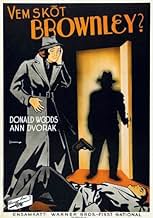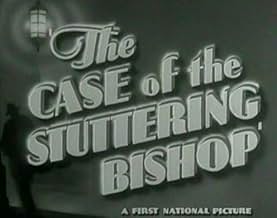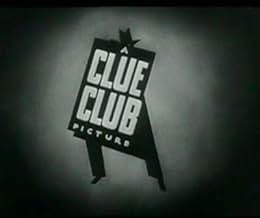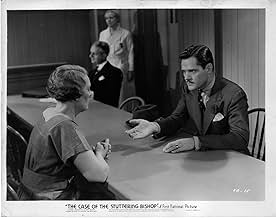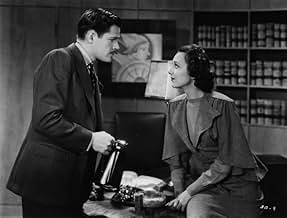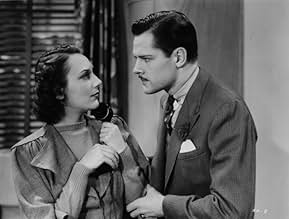AVALIAÇÃO DA IMDb
6,2/10
611
SUA AVALIAÇÃO
Adicionar um enredo no seu idiomaAn improbable stuttering bishop from Australia asks for Perry Mason's help in proving the identity of the legitimate heir to a millionaire.An improbable stuttering bishop from Australia asks for Perry Mason's help in proving the identity of the legitimate heir to a millionaire.An improbable stuttering bishop from Australia asks for Perry Mason's help in proving the identity of the legitimate heir to a millionaire.
- Direção
- Roteiristas
- Artistas
Helen MacKellar
- Stella Kenwood
- (as Helen McKellar)
Charles C. Wilson
- Hamilton Burger
- (as Charles Wilson)
Eddy Chandler
- Detective James Fleet
- (não creditado)
- Direção
- Roteiristas
- Elenco e equipe completos
- Produção, bilheteria e muito mais no IMDbPro
Avaliações em destaque
Case of the Stuttering Bishop, The (1937)
** 1/2 (out of 4)
Sixth and final film in Warner's Perry Mason series features a new guy in the lead role but the film turns out to be a rather entertaining entry. This time out, Perry Mason (Donald Woods) is visited by a bishop who asks him to investigate a manslaughter that happened twenty-two years earlier but the guilty party is still free. Perry starts to investigate, which leads him to a billionaire who eventually winds up dead and it seems the same person is behind the two cases. This is a pretty strong film that manages to be quite entertaining, although it would have benefited by a stronger supporting cast. Woods is actually very good in the role of Mason and brings his own charm and brains to the role. Ann Dvorak is entertaining as his secretary but the rest of the cast is so-so at best. The case is actually very well written and manages to be quite complicated, which ruins the ending when we get the typical easy way out and that's the guilty person getting away with it until they break down and admit everything.
** 1/2 (out of 4)
Sixth and final film in Warner's Perry Mason series features a new guy in the lead role but the film turns out to be a rather entertaining entry. This time out, Perry Mason (Donald Woods) is visited by a bishop who asks him to investigate a manslaughter that happened twenty-two years earlier but the guilty party is still free. Perry starts to investigate, which leads him to a billionaire who eventually winds up dead and it seems the same person is behind the two cases. This is a pretty strong film that manages to be quite entertaining, although it would have benefited by a stronger supporting cast. Woods is actually very good in the role of Mason and brings his own charm and brains to the role. Ann Dvorak is entertaining as his secretary but the rest of the cast is so-so at best. The case is actually very well written and manages to be quite complicated, which ruins the ending when we get the typical easy way out and that's the guilty person getting away with it until they break down and admit everything.
Most of Edward McWade's roles were uncredited, but he certainly paid his dues in film-making; he had been making movies since 1919. Here he plays the stuttering bishop, who shows up at the office of Perry Mason (Donald Woods this time... Warren William had been playing Perry Mason for most of the 1930s.) with a case, then disappears. He makes accusations against the local rich man, Renald Brownley, played by Douglas Wood. Anne Dvorak and Joseph Crehan in supporting roles, as Mason confronts Brownley and tries to sort out the clues and what's going on. People start turning up dead, people are fighting, and then we're in the courtroom, like any good episode of Perry Mason. There are some comical moments, mostly between Mason and Della Street, and the names are a little confusing, with a Della, a Stella, TWO girls named Janice, and even an Ida. It's solid enough, with the usual court-room drama and outbursts. Directed by William Clemens, who had also directed many of the Nancy Drew and The Falcon films.
As someone who has read all 82 of the Perry Mason novels, I have to say that this is the best I've seen of the Warner Brothers Perry Mason films. Readers of Gardner's mysteries will appreciate how faithfully the screen writers were able to keep to the essentials of the original plot in this short 70 minute film.
This film is far superior to the turkeys WB made with Warren William (although that's not saying much.) And Donald Woods was more like the literary Mason than Raymond Burr, who was almost fat enough by the end of the TV series to play Nero Wolfe!
And, of course, there's the great 1930's atmosphere in this film, something the TV series could never hope to reproduce.
This film is far superior to the turkeys WB made with Warren William (although that's not saying much.) And Donald Woods was more like the literary Mason than Raymond Burr, who was almost fat enough by the end of the TV series to play Nero Wolfe!
And, of course, there's the great 1930's atmosphere in this film, something the TV series could never hope to reproduce.
We had two great evolutionary paths in the 30s. One was an amazing diversity of invention to settle some basic narrative devices that have since served us well as the basic vocabulary of cinema. The other, parallel path was the pulp detective novel, a master of which was Gardner.
The traditional, Holmes form is that you are linked to the detective. You discover what he does. Christie followed this form, but it is difficult to render in film. Gardner may be the first case — since common — of the novel adopting cinematic form. His formula does seem friendly to film: we see events that Mason does not, often before he gets seriously engaged. These events give us a false impression of what happened, so we as viewers start out with a deficit.
Then we have the detection; Mason and company are detectives in act two. The third act is always a courtroom, which is why our detective has to be a lawyer. Courtroom conventions have their own evolution in film, and this instance is limited to what in Christie's stories has to be a contrived assembly of the suspects.
This format allows for more complicated mysteries than were usual in film. My own preference for 30's detection is Philo Vance because the formula was not so strict. But this is a good one in terms of allowing complexity and surprise. We have that here in this solid instance.
One of the decisions in defining the characters is how intimate to make the relationship between alpha male Mason and his pretty and competent secretary. Why this matters has to do, as Mason would say, with motive. We like the guy. He is smart, as smart as other detectives, but why he does what he does
In some renderings of the Mason format, he just likes to win. He has his own Lestrade who he likes humiliating. Justice is incidental, and truth merely a tactic. He just like to strut.
In other renderings, he does what he does because he loves his team, his closest friend Drake and his lover Della. Both are profoundly loyal and true. He struts for her and we imagine passion after the obligatory Italian restaurant scene.
Here, a delicate balance between the two is maintained.
The traditional, Holmes form is that you are linked to the detective. You discover what he does. Christie followed this form, but it is difficult to render in film. Gardner may be the first case — since common — of the novel adopting cinematic form. His formula does seem friendly to film: we see events that Mason does not, often before he gets seriously engaged. These events give us a false impression of what happened, so we as viewers start out with a deficit.
Then we have the detection; Mason and company are detectives in act two. The third act is always a courtroom, which is why our detective has to be a lawyer. Courtroom conventions have their own evolution in film, and this instance is limited to what in Christie's stories has to be a contrived assembly of the suspects.
This format allows for more complicated mysteries than were usual in film. My own preference for 30's detection is Philo Vance because the formula was not so strict. But this is a good one in terms of allowing complexity and surprise. We have that here in this solid instance.
One of the decisions in defining the characters is how intimate to make the relationship between alpha male Mason and his pretty and competent secretary. Why this matters has to do, as Mason would say, with motive. We like the guy. He is smart, as smart as other detectives, but why he does what he does
In some renderings of the Mason format, he just likes to win. He has his own Lestrade who he likes humiliating. Justice is incidental, and truth merely a tactic. He just like to strut.
In other renderings, he does what he does because he loves his team, his closest friend Drake and his lover Della. Both are profoundly loyal and true. He struts for her and we imagine passion after the obligatory Italian restaurant scene.
Here, a delicate balance between the two is maintained.
Donald Woods takes over the role of Perry Mason in the last of the Mason series that Warner Brothers did in the 30s with Ann Dvorak as Della Street in
The Case Of The Stuttering Bishop. Erle Stanley Gardner's lawyer/sleuth
would have to wait for television and Raymond Burr for its next incarnation.
Edward McWade, a bishop who stutters comes from Australia to see Woods about a possible fraud being perpetrated on millionaire Gordon Oliver regarding a fake granddaughter being foisted upon him. Later on Myra McKinney, Oliver's estranged daughter-in-law is arrested and it's Perry Mason for the defense.
Hamilton Burger played by Charles Wilson and Joseph Crehan as Paul Drake also appear. Burger for his one and only time in the movie series and Drake is a more traditional private eye. Previously Drake was "Spudsy Drake" played for comic relief by Allen Jenkins in previous films.
Viewers of the classic TV series will note that this observes the Perry Mason paradigm about never having guilty clients and the killer being unmasked in court. Previous films strayed from that somewhat.
I have to mention Tom Kennedy who took a leave from the Torchy Blaine series and brought his usual thick as a brick detective character with him. He's a favorite so incredibly droll and so naive.
Watch it for Tom Kennedy alone.
Edward McWade, a bishop who stutters comes from Australia to see Woods about a possible fraud being perpetrated on millionaire Gordon Oliver regarding a fake granddaughter being foisted upon him. Later on Myra McKinney, Oliver's estranged daughter-in-law is arrested and it's Perry Mason for the defense.
Hamilton Burger played by Charles Wilson and Joseph Crehan as Paul Drake also appear. Burger for his one and only time in the movie series and Drake is a more traditional private eye. Previously Drake was "Spudsy Drake" played for comic relief by Allen Jenkins in previous films.
Viewers of the classic TV series will note that this observes the Perry Mason paradigm about never having guilty clients and the killer being unmasked in court. Previous films strayed from that somewhat.
I have to mention Tom Kennedy who took a leave from the Torchy Blaine series and brought his usual thick as a brick detective character with him. He's a favorite so incredibly droll and so naive.
Watch it for Tom Kennedy alone.
Você sabia?
- CuriosidadesAuthor Erle Stanley Gardner objected so vehemently to what he felt was the miscasting of Ricardo Cortez as Mason, that Warners replaced him with Donald Woods.
- Erros de gravaçãoNear the end, when Mason and his crew are having lunch during a court recess, Della drops her fork on her plate and reaches out across the table to break off some bread (after giving Mason the inadvertent hunch about Stella Kenwood). When the camera cuts back to Mason, Della has fork in hand again, but not the bread.
- Citações
Perry Mason: [to Della] Bishops don't often need lawyers. Show him in.
- ConexõesFeatured in À beira do abismo (1946)
- Trilhas sonorasWhen Irish Eyes Are Smiling
(1912) (uncredited)
Music by Ernest Ball
Lyrics by Chauncey Olcott and George Graff
Sung a cappella with a phony Irish brogue by Donald Woods
Principais escolhas
Faça login para avaliar e ver a lista de recomendações personalizadas
Detalhes
- Data de lançamento
- País de origem
- Idioma
- Também conhecido como
- The Case of the Stuttering Bishop
- Locações de filme
- Empresa de produção
- Consulte mais créditos da empresa na IMDbPro
- Tempo de duração1 hora 10 minutos
- Cor
- Mixagem de som
- Proporção
- 1.37 : 1
Contribua para esta página
Sugerir uma alteração ou adicionar conteúdo ausente

Principal brecha
By what name was O Mistério da Doca (1937) officially released in India in English?
Responda
